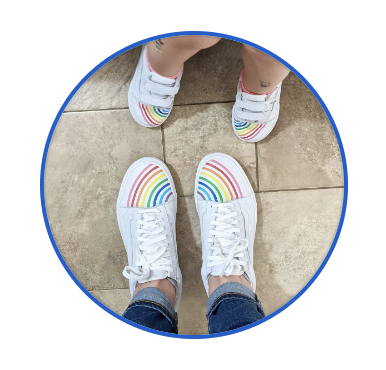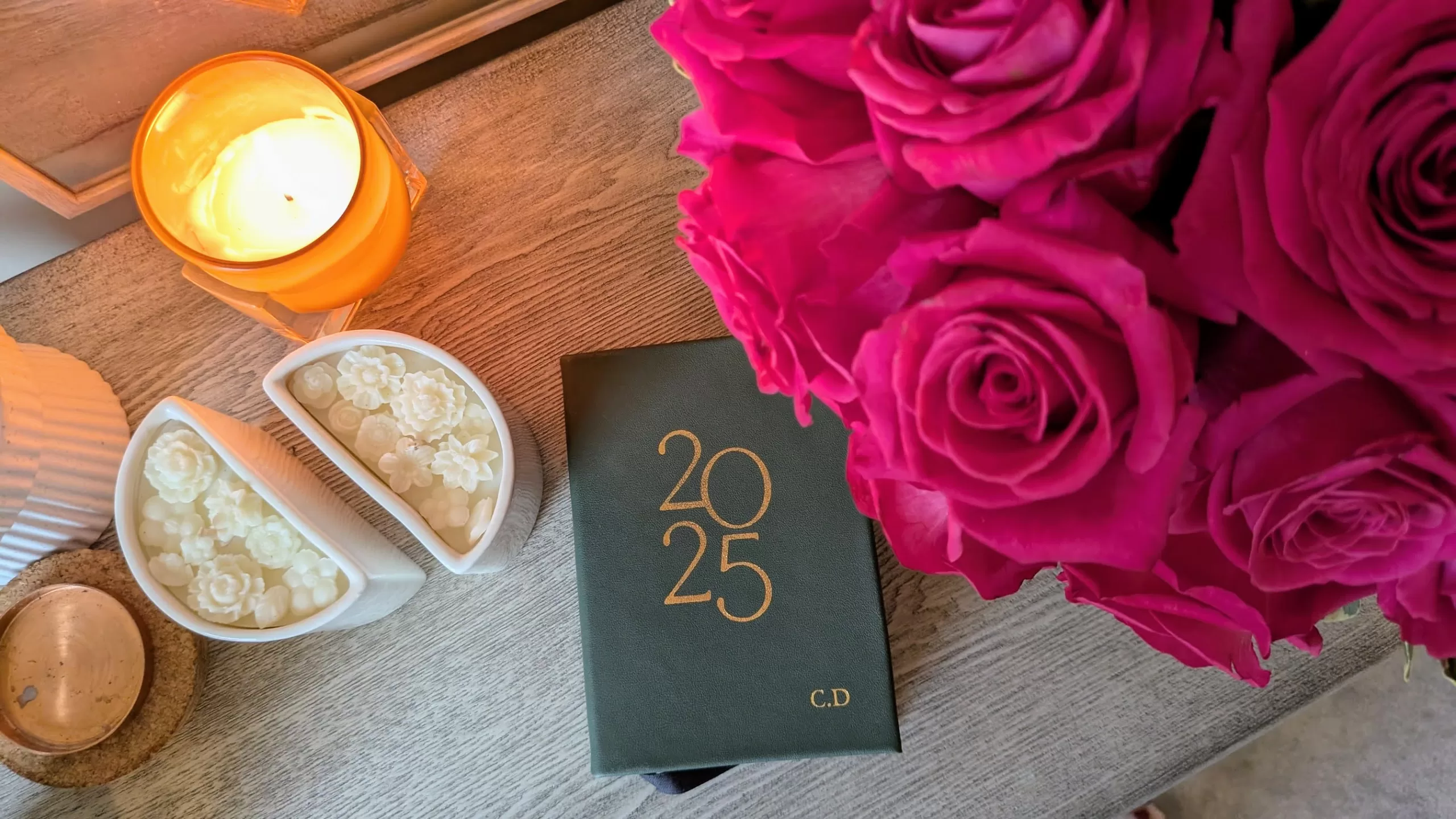This post may contain affiliate links. Every link is hand-selected by our team, and it isn’t dependent on receiving a commission. You can view our full policy here.
Editor’s Note: Hi, everyone! We’re psyched to feature Thalia-Maria Tourikis of Notes by Thalia today. She offers a refreshingly low-maintenance approach to wellness we can really get behind, and we hope you do too.
By Thalia-Maria Tourikis
One of the biggest misconceptions surrounding self-care is that it has to be long.
Open Instagram or TikTok and chances are when you search “self-care” you will be bombarded with hundreds of videos showing beautiful, slender girls waking up at 5 a.m., drinking green matcha lattes, heading to the gym, doing a 12-step skincare routine and going on a hot girl walk.
Even I have to admit, that version of self-care is overwhelming AF.
Who has the time to spend 3 hours or longer on self-care during the week, let alone over the weekend?
And that is why I encourage a simple, stripped-back version of self-care. Because it doesn’t need to be an all-day event to be effective. Self-care can simply look like taking a 3-minute break in between tasks or getting outside for some fresh air.
I’m here to show you how to dedicate time to that version of self-care (rather than the unrealistic version you see on social media).
What Is Self-Care?
By definition, self-care is any activity you do to help take better care of your physical, mental and emotional well-being.
However, it’s important to note that there is no one-size-fits-all approach to self-care. It is unique to the individual. What works for me might not necessarily work for you.
For example, my ideal form of self-care is having a slow morning and reading my book for 30 minutes before I do anything else. But yours might be waking up early and heading to the gym to get in a workout before starting work.
That is why it’s essential that you don’t just copy the self-care routines you see online as they might fail to benefit you.
The truth is, self-care should never feel like a chore, otherwise, what’s the point?
Self-care should be an uncomplicated practice that you turn to in that moment to give you what you need.
So take the time to find those simple but powerful activities that support your daily well-being.
For me, it’s anything that brings me joy or makes me feel grounded. This typically looks like reading a fiction book, going for a swim, doing a jigsaw puzzle or watching the sunset.
And because I’m clear on what rituals nourish me, I can be intentional with my self-care practice rather than indulging in a random activity that I won’t benefit from. (This is manifestation and crystal healing for me.)
The Benefits of Self-Care
When done correctly, self-care is supposed to make you feel good both on the inside and on the outside.
Yes, it may feel uncomfortable sometimes, especially if you’re doing a lot of inner healing work, but overall, self-care should positively impact your health and well-being long after the initial dopamine hit has worn off.
For example, doing yoga or meditation can be viewed as healthy self-care activities. Whereas mindlessly scrolling social media or eating lots of junk food might be seen as unhealthy forms of self-care.
It’s important that when you come to writing your feel-good activities list (I’ll explain this below), you focus on activities that do just that—make you feel good.
Engaging in a self-care practice that works for you can also:
- Increase energy levels
- Boost your mood
- Reduce stress and anxiety (Mental Health First Aid, 2022)
- Teach you to appreciate your own company
- Nurture a better relationship with yourself
- Encourage personal growth
- Promote a healthy work-life balance
How to Incorporate Self-Care into Your Week
1 | Write a feel-good activities list
If you’re new to self-care, it’s important to first establish the things you enjoy doing.
Grab a notebook and pen, and brain dump all the activities you can think of that light you up inside. Focus on writing down at least 10-15 activities.
Keep them simple and realistic whereby you know you can easily fit them into your day, week or month. For example, going on a long woodland walk, getting stuck into a new hobby or taking yourself out on a solo date.
Once you’ve written your list, keep it somewhere visible or accessible so you can refer back to it when you need to. (Bonus points if you turn it into a creative collage and laminate it.)
2 | Focus on your needs
When writing your feel-good activities list, it’s important that you pay close attention to your needs.
Use these journal prompts to help you with this:
- What do I usually need at the end of the day?
- What triggers my overwhelm?
- What are my biggest stressors?
- How do I want to feel by the end of the day?
- What helps me decompress after a long, busy day?
- What else makes me feel good?
Remember, self-care isn’t always about hot baths and pampering.
It’s about human needs.
So when you dedicate time to self-care, make sure you’re doing something that will actually benefit you, that you look forward to doing. For example, don’t force yourself to go on a run if all you want to do is rest and relax with a good book.
By focusing on your needs first, you can intentionally choose an activity that directly addresses those needs rather than indulging in a random activity you won’t benefit from.
There are 8 pillars of self-care, so make sure you include activities for each of these areas. That way you never fall short of the ideal ritual you need in that moment.
3 | Schedule 2-3 activities each week
Now that you have a list of 10-15 feel-good self-care activities, you can start to incorporate them into your week.
When you do your weekly planning (I recommend doing it on a Sunday as part of your reset routine), I want you to choose two to three of the activities you wrote down and schedule them into your week.
Pay close attention to how you are feeling in that moment: How is your week looking? What do you think you will need?
It might also be a good idea to write down two backup activities in case your needs change.
Then, schedule them in! Open your calendar and pinpoint a time in your week when you can engage in these activities. You don’t need to do all of them at the same — sprinkle them throughout your week for maximum benefit or repeat them each day just like you would a habit.
Why two to three activities? That number offers an ideal balance between building the habit of self-care and flexibility in case things don’t go to plan (because life does happen).
Feel free to adjust this number higher or lower to a point where it suits you and your lifestyle. The key is to ensure that these self-care activities are realistic and can easily fit into your daily life.
4 | Use The Balanced Self Wheel
If you’re struggling to know how to schedule in your self-care activities, then get visual.
Let me introduce you to the Balanced Self Wheel.
I came up with this concept a couple of years ago on my own self-care journey, and it has worked wonders on me.
Here’s how it works:
Step 1 = On a piece of paper, draw a circle and divide this into 3 equal parts
Step 2 = Write one of the below phrases in each segment of your wheel leaving space below:
- Be Productive
- Be Playful
- Be Restful
Step 3 = Write down your top 3-5 priorities for the week within the ‘Be Productive’ segment
Step 4 = Add 1-2 fun activities for the week within the ‘Be Playful’ segment
Step 5 = Add 1-2 calming activities for the week within the ‘Be Restful’ Segment
Step 6 = Schedule it into your calendar
The secret to incorporating self-care into your week is to treat it as a non-negotiable like you would work commitments. And by using this method, you can visually see how balanced your week looks.
N.B. Feel free to re-label each section of your wheel with other words that better suit you and your needs.

5 | Establish self-care reminders
Just because you’ve written down what self-care activities you’re going to do and when, doesn’t mean you’re actually going to do them.
Writing them down is only half of the battle. You need to commit from the inside and hold yourself accountable.
So how can you do this?
Establish self-care reminders that prompt you into taking your well-deserved me-time.
For example, set an alarm at the time you’re most available during the day and when it goes off, say to yourself, “Ok, it’s time for a self-care break!.”
You’re more likely to do something if you have a trigger to prompt you so don’t underestimate the power of reminders.
Hot tip → If your alarm goes off and you really can’t get away for a self-care break, then at least spend a few minutes checking in with yourself to see how you are feeling. Reflect on what currently feels good and what feels off. And think about the small steps you can take to make the rest of your day 1% better.
Quick and simple self-care ideas to add to your week
Need some inspiration getting started?
Here are some quick and simple ideas to try as part of your weekly self-care routine:
- Set at least 10 minutes aside to read
- Go on a 20-minute walk
- Do a 25-minute yoga flow
- Take a 7-minute break twice a day
- Journal or practice gratitude for 5 minutes in the morning
- Get at least 10 minutes of fresh air in the afternoon
- Spend 2 minutes checking in with yourself
- Wind down 30 minutes before bed
- Go screen-free for at least 1 hour in the morning
- Do 3-mins of breathwork after a work meeting
- Give yourself a 1 minute hug at the end of the day
- Listen to your favourite song
- Have a 10-minute dance party when you need a pick-me-up
- Try the 54321 grounding method
- Blast yourself with cold water for 30 seconds at the end of your shower
- Say “I’m doing great” three times when you need an mood boost
- Write down 3 wins from the day
Final thoughts
The simplest of rituals can have the biggest impact on your overall health and well-being.
Self-care for that reason doesn’t need to look like an all-day event that is only reserved for a Sunday. It can simply look like taking a 5-minute break during the day and getting outside in nature for some fresh air.
So take the time to find those simple activities that make you feel good and that can easily fit into your weekly schedule.
Don’t just do whatever seems most popular on social media and wonder why it’s not working.
Always prioritize you and your needs first.

Bio: Get to Know Thalia
Hey, it’s Thalia!
I’m not like the other wellness girls you see online. I don’t drink coffee or matcha lattes and I’m not a huge fan of green smoothies. Give me a medium-rare steak with a glass of red wine any day and I’ll be a very happy girl.
I’m also famous for my slow mornings. You won’t see me waking up at 5 a.m. and following an unsustainable “That Girl” routine but instead ignoring my alarm and choosing to read a fiction book over going to the gym.
For the past three years, I’ve been empowering women to stop copying what everyone else is doing and do what works for them. So if you’re craving a more realistic approach to wellness, you can find me on Instagram and Pinterest all under @notesbythalia. And for deeper “how-to” posts that empower you to do things on your own terms, head over to my blog notesbythalia.com.
Lead Photo: Candace Braun Davison




